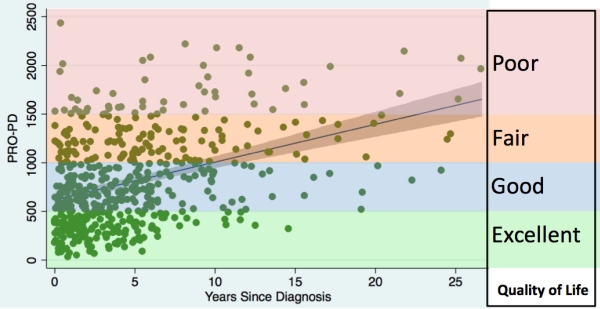Session Information
Date: Wednesday, June 22, 2016
Session Title: Rating scales
Session Time: 12:00pm-1:30pm
Location: Exhibit Hall located in Hall B, Level 2
Objective: To evaluate whether a novel outcome measure, Patient-Reported Outcomes in Parkinson’s disease (PRO-PD), correlates with disease duration, quality of life and established measures of PD severity.
Background: The PRO-PD is an outcome measure designed to capture disease status and severity in an inexpensive, clinically relevant, and comprehensive fashion. It was designed to require minimal time and instruction, while assessing patient perception of both motor and non-motor symptoms. The participant is asked to rate symptom severity, on average, over the previous seven days. The PRO-PD is the cumulative score of 33 slider bars. The goal was to create a continuous outcome measure that does not require a clinical exam, is not responsive to fluctuations in dopaminergic medications, takes only a few minutes to complete, and allows for stratification by symptom(s).
Methods: The PRO-PD is an outcome measure in three ongoing studies; the baseline data from these datasets was pooled and investigated. Symptom frequency and severity are described, Pearson’s correlation coefficients and regression analysis were used to determine whether PRO-PD scores increased as a function of time and correlated with established clinical outcome measures.
Results: Three studies provided 902 participants for analysis, 58 of whom were physically examined. The most frequently reported PD symptoms were impaired handwriting/ typing (91.8%), fatigue (91.2%), slowness (89.8%), daytime sleepiness (89.7%), muscle cramps (88.9%), forgetfulness (87.6%), impaired sense of balance (86.9%), and hyposmia (86.0%) Of the 33 variables, only tremor and nausea did not show a statistically significant increase over time. PRO-PD scores correlated with disease duration (r=0.388, P < 0.000), total UPDRS (r=0.446, P=0.008), patient-assessed Hoehn & Yahr (r=0.636, P <0.000), PDQ-39 (r=0.763, P<0.000), PROMIS Global quality of life question (r=-0.744, P<0.000), and the Timed Up and Go (TUG) (r=0.457, P<0.006). PRO-PD non-motor sub-score correlated with Non-Motor Symptom Scores (NMSS) (r=0.911, P<0.000).
Conclusions: PRO-PD correlates with other established exam-based measures of disease severity. This simple, open-access, patient-centered outcome measure may have utility for patients, providers, and researchers. Future validation efforts should evaluate test-retest reliability and change over time within individuals.
To cite this abstract in AMA style:
L.K. Mischley. Patient reported outcomes in Parkinson’s disease (PRO-PD) rating scale validation [abstract]. Mov Disord. 2016; 31 (suppl 2). https://www.mdsabstracts.org/abstract/patient-reported-outcomes-in-parkinsons-disease-pro-pd-rating-scale-validation/. Accessed April 26, 2025.« Back to 2016 International Congress
MDS Abstracts - https://www.mdsabstracts.org/abstract/patient-reported-outcomes-in-parkinsons-disease-pro-pd-rating-scale-validation/
